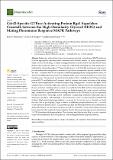Cdc42-Specific GTPase-Activating Protein Rga1 Squelches Crosstalk between the High-Osmolarity Glycerol (HOG) and Mating Pheromone Response MAPK Pathways
Author(s)
Patterson, Jesse C.; Goupil, Louise S.; Thorner, Jeremy
Downloadbiomolecules-11-01530-v3.pdf (6.102Mb)
Publisher with Creative Commons License
Publisher with Creative Commons License
Creative Commons Attribution
Terms of use
Metadata
Show full item recordAbstract
Eukaryotes utilize distinct mitogen/messenger-activated protein kinase (MAPK) pathways to evoke appropriate responses when confronted with different stimuli. In yeast, hyperosmotic stress activates MAPK Hog1, whereas mating pheromones activate MAPK Fus3 (and MAPK Kss1). Because these pathways share several upstream components, including the small guanosine-5'-triphosphate phosphohydrolase (GTPase) cell-division-cycle-42 (Cdc42), mechanisms must exist to prevent inadvertent cross-pathway activation. Hog1 activity is required to prevent crosstalk to Fus3 and Kss1. To identify other factors required to maintain signaling fidelity during hypertonic stress, we devised an unbiased genetic selection for mutants unable to prevent such crosstalk even when active Hog1 is present. We repeatedly isolated truncated alleles of <i>RGA1</i>, a Cdc42-specific GTPase-activating protein (GAP), each lacking its C-terminal catalytic domain, that permit activation of the mating MAPKs under hyperosmotic conditions despite Hog1 being present. We show that Rga1 down-regulates Cdc42 within the high-osmolarity glycerol (HOG) pathway, but not the mating pathway. Because induction of mating pathway output via crosstalk from the HOG pathway takes significantly longer than induction of HOG pathway output, our findings suggest that, under normal conditions, Rga1 contributes to signal insulation by limiting availability of the GTP-bound Cdc42 pool generated by hypertonic stress. Thus, Rga1 action contributes to squelching crosstalk by imposing a type of “kinetic proofreading”. Although Rga1 is a Hog1 substrate in vitro, we eliminated the possibility that its direct Hog1-mediated phosphorylation is necessary for its function in vivo. Instead, we found first that, like its paralog Rga2, Rga1 is subject to inhibitory phosphorylation by the <i>S. cerevisiae</i> cyclin-dependent protein kinase 1 (Cdk1) ortholog Cdc28 and that hyperosmotic shock stimulates its dephosphorylation and thus Rga1 activation. Second, we found that Hog1 promotes Rga1 activation by blocking its Cdk1-mediated phosphorylation, thereby allowing its phosphoprotein phosphatase 2A (PP2A)-mediated dephosphorylation. These findings shed light on why Hog1 activity is required to prevent crosstalk from the HOG pathway to the mating pheromone response pathway.
Date issued
2021-10Department
Koch Institute for Integrative Cancer Research at MITJournal
Biomolecules
Publisher
Multidisciplinary Digital Publishing Institute
Citation
Biomolecules 11 (10): 1530 (2021)
Version: Final published version
ISSN
2218-273X